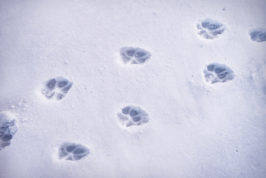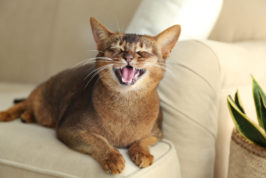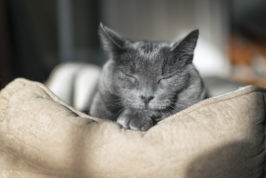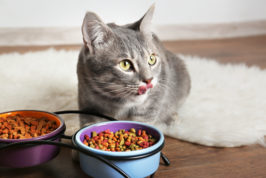Cats should produce well-formed, firm faeces that are light to dark brown in colour. If a cat is suffering from Diarrhoea, his or her stools may become soft, unformed or of a liquid consistency. You might also notice a change in colour. Diarrhoea is not an uncommon ailment in cats, and there are a large number of possible causes. Dr Gemma Cliffin explains all…
Acute and Chronic Diarrhoea

Diarrhoea is classified by vets as either being acute – a single, isolated episode, or chronic, which is usually defined as lasting for a duration of longer than three weeks. Diarrhoea may also be considered chronic if there have been several short episodes that occur close together. Even if normal faeces have been produced in between.
As a general rule, Acute Diarrhoea is more common in kittens and young cats, and Chronic Diarrhoea is more likely to be seen in older cats. However, this isn’t always the case, and Acute or Chronic Diarrhoea can be seen in cats of all ages.
The majority of cases of Diarrhoea in cats are caused by primary intestinal disease. In other words, a disease that originates in the digestive tract itself. Other cases may be as a result of systemic disease, i.e. a disease of another organ or organ system within the body, that in turn affects the digestive tract.
Diarrhoea in kittens and young cats
Diarrhoea in kittens and young cats is more likely to be acute. You may notice that your cat is passing faeces far more regularly than usual, and straining when they do. Cats with an acute episode of Diarrhoea are usually well in themselves, unless their Diarrhoea is very severe.
Signs of more severe disease include concurrent vomiting, a lack of appetite, or blood in the Diarrhoea. In these cases, cats can quickly become dehydrated through water loss in their faeces – particularly when they’re passing large volumes of liquid faeces more frequently than they usually would. Signs of dehydration in cats include lethargy, appetite loss, gums that are tacky to touch and loss of elasticity in the skin (sometimes referred to by vets as ‘skin tenting’).
If your cat is showing any of these signs, then contact your vet immediately for advice.
Causes of Acute Diarrhoea
There are various possible causes of Diarrhoea in young cats and kittens, but some of the most common causes include:
- Diet
The sudden introduction of a new food, a dietary intolerance, or the scavenging of an inappropriate food is one of the most common reasons for a single episode of Diarrhoea in cats. This type of Diarrhoea is usually self-limiting, and will improve within a few days. Sometimes, if a cat is intolerant to the food he or she is being fed, the Diarrhoea will not resolve until that food is removed.
- Parasitic infections
It’s common for kittens to have worms – particularly if their mother was not wormed throughout her pregnancy, and the kittens were not wormed by the breeder. Young cats that are hunters may also carry a high worm burden if they’re not wormed regularly. Make sure you speak to your vet about the most appropriate worm treatment for your cat, and bear in mind that some over-the-counter products may be ineffective at eliminating worms. Other non-worm parasites, such as Giardia and Tritrichomonas, are also common in young cats but can be trickier to eliminate. Your vet will be able to diagnose these and offer treatment if necessary.
- Bacterial infections
Sometimes, young cats with Diarrhoea are found to be carrying and shedding bacteria in their faeces, such as Salmonella and Campylobacter. Your vet will be able to diagnose these by obtaining faecal samples from your cat. Both of these bacteria are known as zoonoses, which means they are transmissible to humans. Good hygiene practices by everyone in the household are essential, particularly among young children, the elderly and the immunosuppressed.
- Viral infections
Less commonly, viruses such as Feline Parvovirus and Feline Leukaemia can cause Diarrhoea. Both of these can cause life-threatening diseases in cats, but are seen far less commonly these days, thanks to highly effective vaccinations.
Treatment of Acute Diarrhoea in cats
Treatment of Acute Diarrhoea may vary slightly according to the cause of the Diarrhoea, but the mainstay of treatment is to feed a fat-restricted, highly digestible intestinal diet until your cat’s Diarrhoea has resolved. The best option is a prescription diet, which is available from veterinary practices. Home-cooked diets are often deficient in vitamins and minerals, which can make it harder for your cat to recover.
There are also products available that contain probiotics and prebiotics which may help to speed up your cat’s recovery. Probiotics are live bacteria – also sometimes known as the ‘good bacteria’ of the gut. Prebiotics are a food source for these good bacteria, and therefore can help encourage their growth. Sometimes, these products also contain natural binding agents, such as psyllium and kaolin, to help firm up your cat’s faeces and provide symptomatic relief.
Antibiotics are rarely required to treat Diarrhoea in cats and may even exacerbate it, as they can destroy the good bacteria in your cat’s gut.
Home recommendations
Make sure your cat has access to plenty of fresh water so that he or she can replace the fluid being lost in the faeces. Allow your cat the chance to rest and recover by ensuring there’s somewhere quiet that they won’t be disturbed. It might also be useful to provide your cat with a litter tray, even if they don’t usually use one, to prevent any accidents in the house.
Diarrhoea in older cats
Older cats are more likely to suffer from Chronic Diarrhoea than younger cats. You may notice a change in the consistency of your cat’s faeces for several weeks, or he or she might have intermittent Diarrhoea that keeps recurring.
If your cat has Chronic Diarrhoea, it’s important to take them to the vet, as this is usually a sign of underlying disease. Chronic Diarrhoea in cats is more likely to be accompanied by weight loss and – depending on the underlying cause – concurrent vomiting. Sometimes, blood and/or mucous may be seen in your cat’s faeces.
Causes of Chronic Diarrhoea
There are many possible causes of Chronic Diarrhoea in cats, but most commonly these include:
- Inflammatory Bowel Disease (IBD)
This is a condition that causes a cat’s digestive tract to become irritated and inflamed. It’s a relatively common cause of Chronic Diarrhoea in cats.
- Hyperthyroidism
Otherwise known as an overactive thyroid, this is a common disease in older cats.
- Vitamin B12 deficiency
Sometimes referred to as cobalamin, Vitamin B12 may need to be supplemented if your cat is found to have low levels of this important nutrient.
- Intestinal tumors
The two most common types of digestive tract cancer (Neoplasia) in cats are Lymphoma and Adenocarcinoma. These can both interfere with the normal absorption of nutrients in your cat’s intestines.
Treatment of Chronic Diarrhoea
Your vet may perform various diagnostic tests to help determine the cause of your cat’s Diarrhoea, and they’ll discuss the treatment with you accordingly. A prescription hydrolysed diet may be required for cats with IBD and other food allergies. Products containing probiotics and prebiotics may be useful to aid your cat’s recovery from Diarrhoea, and are often used alongside the main treatment.
Conclusion
Diarrhoea in cats is a common condition and there are lots of possible causes. If your cat has a short, on-off episode of Diarrhoea and is otherwise well then this will usually resolve on its own. Recovery could be aided by feeding an easily digestible food for a few days. If your cat has Diarrhoea and seems unwell in any way, or the Diarrhoea is persisting for more than a couple of weeks, then you should take him or her to the vet to get checked over.




